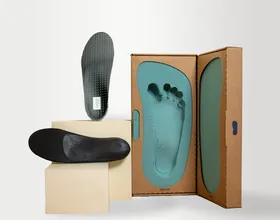What Shoes Can You Put Orthotics In?
Custom orthotics are designed for a specific type of shoe, but you can usually use them in similar shoes. Find out which in this article.
Published July 8, 2021.
When it comes to orthotics, many people wonder what type of shoes you can put them in. While over-the-counter orthotics can work with any shoe type, custom orthotics present a better alternative.
Apart from using them with any type of shoe, the same custom orthotic insole is also designed to fit different styles of shoes. Consequently, they are more effective in producing desired outcomes, especially with foot pathology.
Custom orthotics also help you save money that would have been spent purchasing different orthotics for different shoes. It also ensures that you can wear your orthotics as often as possible, regardless of the style of shoe you need to wear. This should be one of the considerations you make when choosing to buy over-the-counter insoles or custom orthotics.
Though orthotics can fit multiple shoe types, it does not mean you can use the same orthotics for all your shoes. Instead, they are built for use with similar shoe types. So while one is used in different activity footwear, such as running shoes and hiking shoes, another is useful for dress shoes like high heels and sandals.
One Size Doesn't Fit All
One orthotic cannot fit every type of shoe, and when it doesn't fit, the orthotics are likely to cause discomfort. This is often the case with over-the-counter insoles, which are pre-made and pre-designed, regardless of your shoe size. But it can also happen with a poorly fitted custom orthotic.
A poorly fitting insole will slide around or stretch your shoe, causing discomfort and depriving you of the full benefits of custom orthotics. In contrast, properly fitting insoles are comfortable, convenient to wear, and effective for your foot needs.
How to Solve the Problem
Orthotics that do not fit the foot well will cause several biomechanical problems, including back, hip, and knee pain. Choosing a properly-fitting orthotic from the different types of custom orthotics available is important to derive maximum benefits from its use. For example, based on your foot complaints and requirements, you should either opt for rigid or soft orthotics.
A quick custom orthotics review will show you that Upstep custom orthotics are one of the best around. Apart from being designed by professional podiatrists, Upstep orthotics are made from quality and durable materials. They are also more affordable than several other custom orthotics on the market.
Ideally, it is best to have at least two pairs of orthotics for maximum benefit. While one can fit into work shoes, the other can work with dress shoes. This ensures that orthotics fit your feet and shoes optimally.
Interestingly, you are eligible for reimbursement under the FSA and HSA plans if you purchase an Upstep orthotic. The firm also provides you with an invoice to that effect.
How Often Should You Change Orthotics?
With time, your orthotics can get worn out or damaged. You may also outgrow it with aging or develop an injury that warrants a different kind of orthotic. In such events, you should consider replacing your orthotics.
While over-the-counter orthotics last an average of six to twelve months, custom orthotics are more durable. Custom orthotics last longer, averaging two to three years of use.
Regardless of the type of insole, you should watch for signs of damage, as any worn-out orthotics will cause further damage to your feet.
Related Articles

Running With Flat Feet: All You Need to Know to Prevent Injury
Janik Sundstrom
October 8, 2024

7 Best Orthotics to Aid With Your Lower Back Pain
Babafemi Adebajo
December 9, 2024

Custom Orthotics for Plantar Fasciitis—2025 Review
Babafemi Adebajo
July 15, 2024

Weightlifting with Flat Feet: Challenges and Solutions
Jasrah Javed
October 14, 2024

How Orthotics for Hammer Toe Can Help You With the Pain
Janik Sundstrom
February 5, 2025
Related Posts
Babafemi Adebajo
Do Heel Cups Help Achilles Tendonitis
Babafemi Adebajo
Treatments for Plantar Plate Tears
Upstep Staff
The Best Orthotic Insoles for Sesamoiditis
Babafemi Adebajo
Best Exercises for Posterior Tibial Tendonitis
Dr. Pooja Gajare
Do Orthotic Insoles Work for Heel Pain?
Babafemi Adebajo
Running Custom Orthotics—2025 Review
Staff Writer



